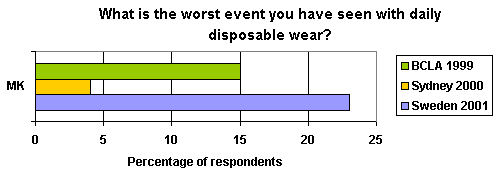Introduction
According to the results of a recent poll conducted on this
website, 45% of 432 respondents have seen microbial keratitis
(MK) with silicone hydrogel lens wear. This percentage was much
higher than expected. Data collected by the CCLRU (see below)
indicate that the incidence of MK is much lower with silicone
hydrogel lens wear. This article provides an explanation as to
why we think these numbers differ.
What We Know About the Incidence of MK with Silicone Hydrogel
Lenses
Although the high oxygen transmissibility of silicone hydrogel
lenses is thought to contribute to a decreased risk of microbial
keratitis (MK) with contact lens wear, MK still occurs with this
lens type. Practitioners must always remain alert to the potential
signs and symptoms of adverse events and must continue to educate
their patients on the necessity for compliance to their wear
schedule and hygiene procedures, irrespective of lens type or
wear modality.
As detailed in this month's editorial, " CW
worldwide, an update on silicone hydrogel use" , the use
of silicone hydrogels has doubled over the past year, making
up 16% of the world-wide contact lens market. Over this time,
the CCRLU, with enormous help from the contact lens industry,
has continued to actively collate anecdotal reports of MK from
practitioners and members of the ophthalmic community at international
meetings. The CCLRU
is also able to include cases identified through pilot surveillance
studies conducted in the UK, and in Australia and New Zealand. To date we are aware of 57 cases
of MK, with the majority coming from the United Kingdom, Australia,
and the USA (Figure 1). Of the 40 cases for which wear schedule
is known, 35 were wearing silicone hydrogels on an extended
or continuous wear basis and 5 were wearing their lenses for
daily wear.
 |
| Figure 1 |
The relatively well-defined
nature of the contact lens wearing population in Australia enables
us to estimate the incidence of MK with some degree of confidence
by consulting anecdotal reports and current lens sales data.
Using 55,000 wearer eye years as a denominator, we estimate that
the incidence of infection with silicone hydrogels is 1 in 3235
wearers per year. It is certain, however, that these numbers
have been underestimated; we should be able to provide an accurate
estimate of the risk of MK with silicone hydrogels once we see
the results of post-market studies being conducted by CIBA Vision
and Bausch & Lomb,
and population-based studies currently being conducted in Australia,
New Zealand and the UK.
The visual outcomes for the 57 patients reported through CCLRU
surveillance are:
• 20: No change
• 4: Loss of one line
of VA or less
• 5: Loss of 2 lines
• 2: Keratoplasty required
• 26: No data
What We Know About the Incidence of MK with Daily, Disposable
Lens Wear
Daily disposable lens wear is generally considered
to be the safest form of daily wear, though no population-based
surveillance studies have been conducted to assess the relative
risk of this modality and anecdotal surveys suggest that quite
a large number of practitioners have seen MK with daily disposable
lens wear (Figure 2). This is far greater than the established
incidence of MK with daily wear of soft lenses would suggest
(1:5000).
 |
| Figure 2 |
This higher than expected rate of MK with daily
disposables may be a result of the potential for misdiagnosis
of MK, particularly because of the many similarities between
MK and contact lens induced peripheral ulcer (CLPU). Although
practitioners must always be conservative in the way they diagnose
and manage MK, it is also important that they learn to be confident
in their ability to differentiate between this event and non-infectious
adverse events such as CLPU. Accurate diagnosis of adverse events
associated with contact lens wear contributes to improved patient
management and satisfaction, decreased chair-time, and more efficient
reporting. See
THE GUIDE TO DIFFERENTIAL
DIAGNOSIS HERE - PDF 317KB
MK vs. CLPU
The most prominent difference between MK and CLPU is the aggressive
worsening of signs and symptoms with MK after the removal of
lenses compared to an improvement in signs and symptoms with
CLPU. Although MK is often seen as a large, irregular lesion
in the central or paracentral region with diffuse infiltration
and small satellite lesions, it can not be categorically defined
by one sign. Infectious lesions can occur in the peripheral regions
of the cornea and may be small, depending on the stage at which
a patient presents. CLPU, on the other hand, is almost always
characterized by a small and circular focal infiltrate in the
periphery to mid-periphery of the cornea and may have surrounding
diffuse infiltration. More detail on the differentiation between
these two events is described in Clinical
Diagnosis of Microbial Keratitis and Contact Lens-Induced Peripheral
Ulcer . Any patient that presents with a central
infiltrate and overlying loss of epithelium or that has irregularly-shaped
focal infiltrates with raised edges or satellite lesions should
be treated as if they have been diagnosed with MK until proven
otherwise. See Management
Algorithm for Contact Lens-Associated Bacterial Keratitis.
Conclusion The threat of MK should not deter any practitioners from prescribing
contact lens wear, though they should also never become complacent.
Practitioner vigilance and good patient education are essential
components of practitioners' duty to ensure an excellent standard
of care. |